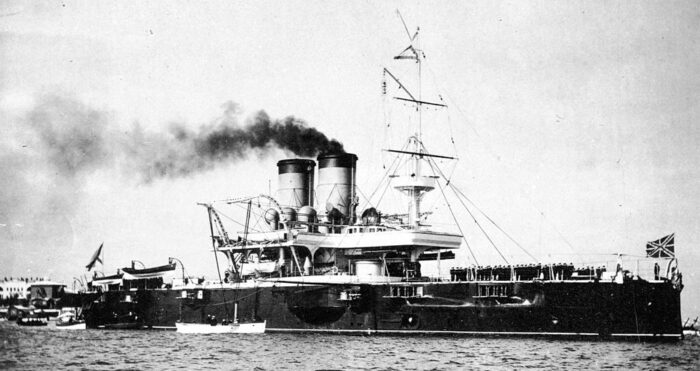
The Ekaterina II class were four battleships of the Imperial Russian Navy, built in the 1880s for the Black Sea Fleet. Their design showed unique, never repated pattern of three main guns barbettes placed in a triangle, two forward ad one aft. Compared to average pre-dreanoughts which just had two barbettes, this made them powerful. The issue was their arc of fire however and soon obsolete protection of their central armored redoubt. This maximized firepower forward, useful for the narrow waters of the Bosphorus and ramming. Construction was slow due to their size and complexity, with the shipyards needed time to be upgraded and handling them.
They stayed in Sevastopol during the Potemkin mutiny by June 1905 with Ekaterina II’s crew disabled to prevent joining her. Chesma escorted Potemkin, towed by Sinop back to Sevastopol from Romania. Sinop and Georgii Pobedonosets also chased Potemkin to Odessa until experiencing mutinies on their own. In 1906, many in the Navy wanted them rebuilt and modernized but this was never done. Ekaterina II and Chesma were sunk as targets in 1907, while Sinop and Georgii Pobedonosets spent WWI as artillery training ships and guardships at Sevastopol, captured by the Germans in 1918, handed over to the British which sabotaged their engines before leaving them captured by the Bolsheviks, then whites in 1919-1920. Sinop was left behind and did not join Wrangel’s fleet in Bizerte while Georgii Pobedonosets was towed there. They were scrapped in 1922 and 1930. #ww1 #russkyflot #sinop #battleship #ironclad #russiannavy
Development
Genesis of the Ekaterina II class
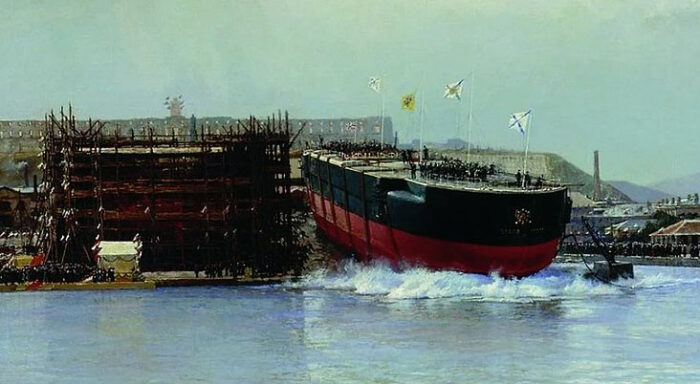
The Ekaterina II-class battleships were initially designedd to support an amphibious assault on the Bosphorus, and oppose any British or French Mediterranean Fleet incursion to force the Bosphorus and enter the Black Sea. They were design with the last Crimean war in mind, as well as the recent 1878 war with the Ottom Empire. They were supposed to engage Turkish coastal artillery batteries and all warships found in the narrow confines of the Turkish Straits, and for this, it was proposed to gave them forward-facing guns only, as she was supposed to turn around and present her broadside. She was also design to fire on the move when making a ramming run.
Eventually, if the arc of fire allowed it, a third barbette was added aft, capable of firing to some angles forward, and this led to the design of three gun mounts, two forward and one aft, a configuration accepted relatively early in the design process back in 1880. But the exact number of guns and choice between turrets or barbettes fed debate for many months. A Russian officers party saw the “disappearing guns” of HMS Temeraire when shelling Alexandria in 1882. They found the idea impressive and wanted an equivament, with the lighter weight of barbettes versus turrets enabling the installation of supplementary 9-inch (229 mm) guns until it was realized more rational to have two gun mounts per barbette instead with a fraction of the weight and cost.
Construction started in 1883 as the armor scheme was revised. At the time a Russian delegation just visited France and saw two naval constructors, notably Bertin’s influence on underwater protection. Back home they milited for a complete waterline armor belt to protect the fore and aft sections. Indeed at the origin, like on HMS Temeraire, these ironclads were to have a short amidship thick belt and unprotected ends except for the armored deck. The armor scheme was drastically revised and compromises made like a max thickness from 18 inches (457 mm) to 16 inches (406 mm) and tapered down to 8 inches (203 mm) at the bow and stern and with 6-inch (152 mm) strake over the ram bow. The middle redoubt was protect against a similar caliber impact, straight fire, at 12-inch (305 mm) but it was shortened from 130 feet (40 m) to 100 feet (30 m) and all ammunition hoists and funnel uptakes replaced. Design displacement when finally approved rose to 10,190 long tons (10,354 t) with a 5 inches (127 mm) greater draft than expected, not ideal for shallow waters. The class comprised initially three ships, Georgii Pobedonosets built later ordered as a modified Ekaterina II design, differing in armor layout and composition. Still, their long construction time made them almost obsolete at completion.
Construction and service
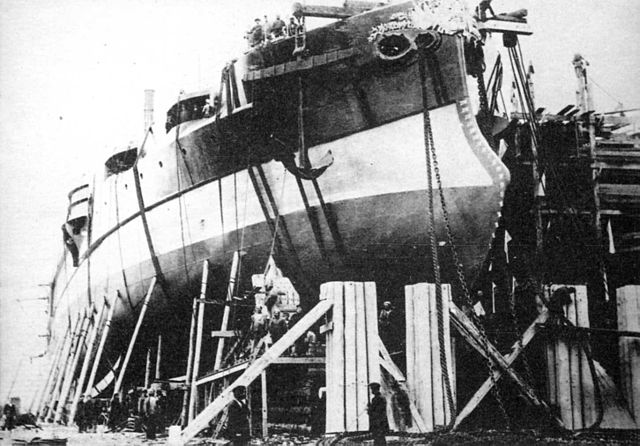
Ekaterina II was built at the Admiralty Shipyard in Nikolayev and her two sisters at Sevastopol (Russian Steam Navigation and Trading Co.). The Admiralty Shipyard required additional preparations and delays amounted before building Ekaterina II. Equipment were also sent from St. Petersburg, but there were also near-constant design changes during construction. The gun mountings ended larger than planned, the redoubt was revised as well as its protection and ended deported on sponsons. Its frontal armor thickness was further reduced from 14 to 12 inches and it was moved back of 10 feet (3 m) while the armor was rearranged.
The initial boilers were considered rapidly obsolete and they were replaced by Belleville water-tube boilers during their main overhauls. Several proposals were made to rebuilf them in a more potent package, notably with two turrets fore and aft, protection revised to modern Krupp armor, or cut them down by one deck. The only ship upgrade was Chesma, which obtained new armor plates and new turrets until it was considered not cost-effective and instead, they were sent to complete Ioann Zlatoust.
Design of the class
Hull and general design
These battleships were quite large. They measured 331 feet 8.5 inches (101.105 m) long at the waterline 339 ft 3 in (103.40 m) overall for a generous beam of 68 ft 11 in (21.01 m) to 1/5 ratio, and draft of 27.92 to 28.83 ft (8.51 to 8.79 m). But they ended overweight with 11,050 to 11,396 long tons (11,227 to 11,579 t) standard, 1,000 long tons (1,000 t) more than as designed. Sinop in 1908 showed a a metacentric height of 4 feet (1.2 m). They were flush deck, two decks high with a midly pronounced ram, rounded cruiser poop with galley, and short structures amidships which looked like British monitor breastwork ones.
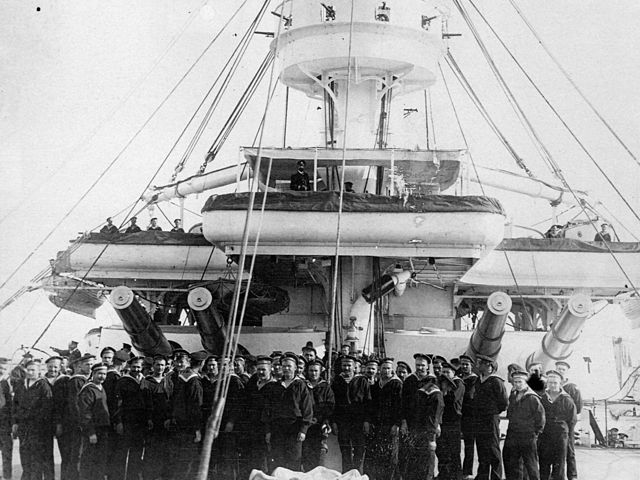
The structure was literraly built above the barbettes, with a conning tower between the forward barbettes, the funnel pair aft of these, close to the aft barbette. The rest was carried by a tall platform supported by a serie of steel pillars. It started at the base of the unique forward military mainmast, topped by a fighting platform for light guns, and a composed upper mast with spotting top. Behind it was located the main bridge, adorned with wood paneling, supporting an open bridge and searchlight. Then cam two walkway wings gaping the beam, and the aft platform surrounding the funnels and air intakes, as well as some service boats. There was a small observation platform aft and light access staircases. The remainder of service boats were under favits on either beam aft.
Protection
The Ekaterina II-class at first had a short and heavily armored central citadel, later changed to a full waterline belt and larger redoubt, less well protected. Compound armor imported from Charles Cammell un UK were used for the first three ships.
Main Belt: max thickness 16 inches tapered down by 2-inch (51 mm) steps to 8 inches, bow and stern. 8 feet (2.4 m) high
Belt tapered down to 6 inches, bottom edge for the 16-inch plates. Designed to be 3 feet (0.9 m) above the waterline but ended at 13 inches (330 mm) above.
Central citadel: Upper deck above the belt, 100 feet (30.5 m) long, 8 feet 6 inches (3 m) high. 12-inch sides, 10-inch (254 mm) forward bulkhead, 9-inch (230 mm) rear bulkhead.
Redoubt: It was 9 feet 6 inches (3 m) high and 12 inches thick. But 15 inches (381 mm) shorter on Sinop to save weight.
Barbettes: They had armored hoods fitted over to protect from small arms and splinters 1.5 in (38 mm) or 2.5 inches (64 mm) thick.
No shields for the 6-inch guns and torpedoes.
Conning tower: 6 in on Ekaterina II, 8 in on Chesma and 9 in walls on Sinop.
Armor deck: 2.5 inches (64 mm) thick over the citadel, 2.25 inches (57 mm) elsewhere.
Centerline longitudinal bulkhead: It extending from frames 17 to 65, with ten transverse watertight bulkheads and complete double bottom.
Georgii Pobedonosets had steel (presumably Krupp) armour. Belt 12 inches tapered down to 6 inches forward, 8 inches aft and 1 foot (0.3 m) lower at 7 feet (2.1 m).
Deck armor: 2.25 inches outside the citadel, 1.5 inches over it.
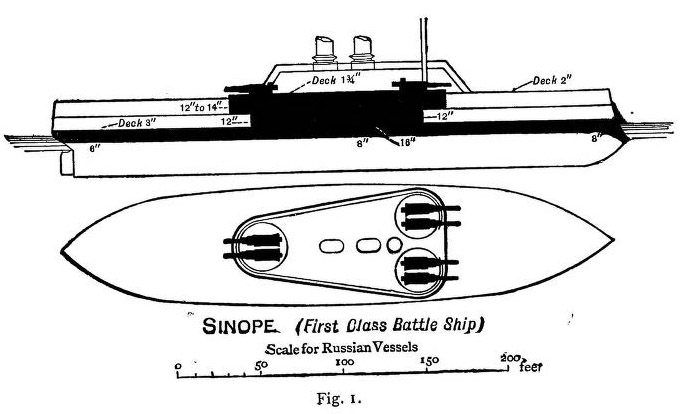
Powerplant
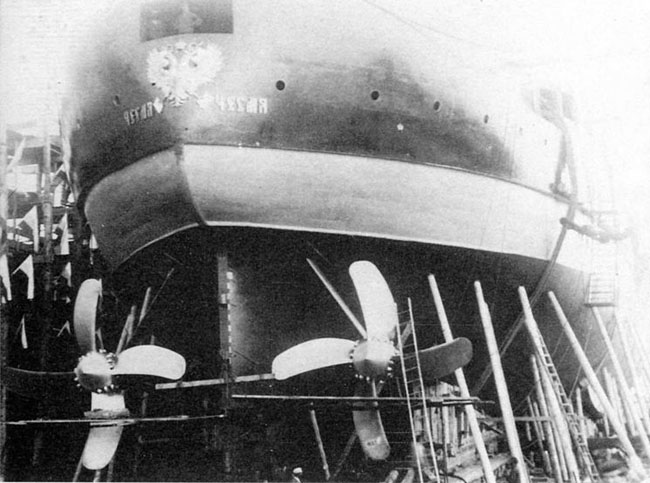
–Ekaterina II and Chesma had a powerplant made of two three-cylinder vertical compound steam engines. These were fed by fourteen cylindrical boilers.
–Sinop and Georgii Pobedonosets instead had vertical triple-expansion steam engines, Sinop being the world’s first so equipped, and still either fourteen (Sinop) or sixteen (Georgii Pobedonosets) cylindrical boilers for steam. They were were imported from UK and France. Those of the Ekaterina II however were made by the Baltic Works. Total designed output went from 8,500 to 10,500 indicated horsepower (6,338 to 7,830 kW). On trials they could reach 15 to 16 knots (28–30 km/h; 17–18 mph) but this fell during service. Autonomy was short on design. They carried just 900 long tons (914 t) of coal when fully loaded. That was enough for 2,800 nautical miles (5,186 km; 3,222 mi), crossing the Black sea and back without issue at ten knots (19 km/h; 12 mph). They could still cross 1,367 nautical miles (2,532 km; 1,573 mi) at 14.5 knots (26.9 km/h; 16.7 mph).
Armament
305 mm Obukhoff M1877
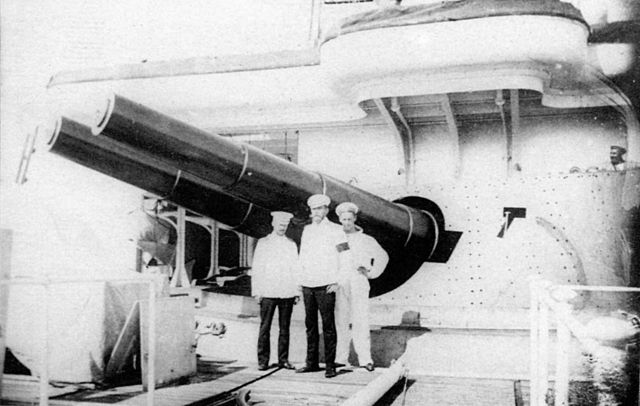
Main armament comprised three pairs of 12-inch (305 mm) guns. This was unusual, as generally four guns was the norm. These were mounted in twin-gun barbettes, protected by a light shielding. The arrangement was unusual, as the classic scheme was en echelon with the two barbettes placed on either side, but with a gap between them in axis, looked like they were placed fore and aft. Instead here, the Russians placed two barbettes side by side forward. The third one was placed aft. They were also close to each others, and occupied a great deal of space. This concentration helped rationalize armour protection, but reduced superstructures to the minimum.
Ekaterina II and Sinop differed from the rest by their Pattern 1877 Obukhoff guns/30 caliber.
Chesma and Georgii Pobedonosets had Obukhov Pattern 1886 35 caliber guns.
The forward mounts could traverse 30° across the bow, 35° abaft the beam or 155° total whereas the rear mount had a 202° arc.
Elevation was limited to −2° to +15°. Rate of fire was a round every 4-5 minutes plus training time, with 60 rounds per gun carried.
Thet were mounted very low, just 4 feet 6 inches (1.37 m)) they had wells in the main deck, but this caused extensive damage to the deck planking when fired over the bow or stern.
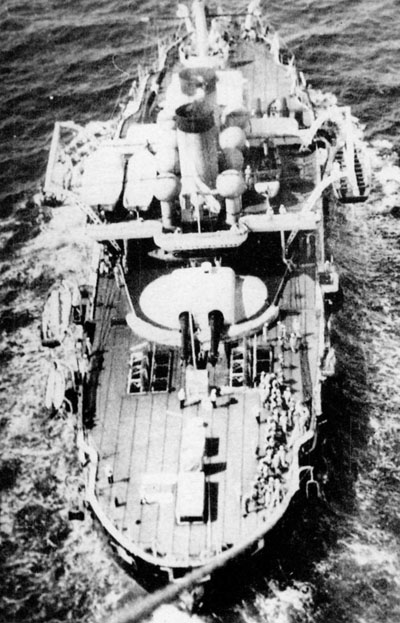 Each ship had a different mount type inside the barbette:
Each ship had a different mount type inside the barbette:
-Ekaterina II had bulky hydraulically-powered Moncrieff “disappearing mounts” inspired by HMS Temeraire. But they proved too large and the outer edges of the armored redoubt were extended over sponsons on the first two ships
-Chesma guns had the same mounts but they were not disappearing.
-Sinop and Georgii Pobedonosets had a new standard, smaller and light mount and no sponsons around the redoubt.
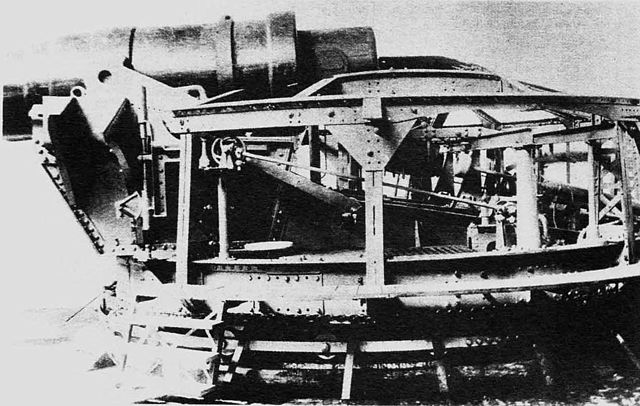
Only the last ship could use the 12-inch 35-caliber guns. Sinop had to use the older 30-caliber model. Georgii Pobedonosets had her redoubt rexorked for these new longer range guns. They were placed in addition, on unbalanced turntables. This had an unexpected effect, and when training to the broadside, the ship started to list. When all three barbettes were turned the same way she listed as much as 7.6°. Grvity alone was such the turntable machinery was unable to rotate the guns back to normal positions. Water tanks were built-in to counteract the list, but they took two hours to fill… In 1892 the turntables were redesigned with improved balance. Other solutions were turned down as too expensive.
-The 30 calibers long Pattern 1877 gun fired a 731.3-pound (331.7 kg) shell at 1,870 ft/s (570 m/s) up to 5,570 yards (5,090 m) at 6°.
-The 35 calibers long Pattern 1886 gun had a velocity of 2,090 ft/s (640 m/s) with the same shell. Range at max elevation jumped to 11,600 yards (10,600 m).
A type of ‘heavy’ shell at 1,003 lb (455 kg) with additional charge was obtained in 1900, with a velocity of 2,000 ft/s (610 m/s) and probably equilvalent range but greater impact.
152 mm Obukhoff M1877
The Ekaterina II class battleship had seven 6-inch (152 mm) Model 1877 35-caliber guns in addition. These were mounted on broadside pivot mounts. They were placed in the battery deck, in hull embrasures. There was however a chase gun mounted in the stern.
These guns had a Maximum elevation was 15°, depression 5°.
Fired a ‘light’ shell of 277–280 lb (126–127 kg) or ‘heavy’ shell of 415-pound (188 kg).
Muzzle velocity depended on weight and propellant:
‘light’ shell (brown powder) 227 Ib: 2,142 ft/s (653 m/s)
‘light’ shell (smokeless powder) 280 Ib: 2,326 ft/s (709 m/s).
‘heavy’ shell (brown powder) 415 Ib: 1,867 ft/s (569 m/s).
Range was 10,330 yards (9,450 m) with the light shell with smokeless powder at 15°.
125 rounds were provided per gun.
47 mm Hotchkiss
Eught 47-millimeter (1.9 in) five-barreled revolving Hotchkiss guns were addded as defensive arrillery, sic six mounts on small sponsons projecting from the hull. Aftermost pair mounted in hull embrasures (Ekaterina II, Chesma). On Sinop, all were mounted in hull embrasures.
On Georgii Pobedonosets’s eight were mounted on the battery deck.
In common, they fired a 3.3-pound (1.5 kg) shell at 1,476 ft/s (450 m/s), 30 rounds per minute, range of 2,020 yards (1,850 m).
37 mm Hotchkiss
Georgii Pobedonosets had ten additional 37-millimeter (1.5 in) single-barreled Hotchkiss guns in her fighting top. The other three had only four of them in the same fighting top.
They fired a 1.1-pound (0.50 kg) shell at 1,450 ft/s (440 m/s), 32 rounds per minute, range 3,038 yards (2,778 m).
To round this up, all ships had the same seven above-water 14-inch (356 mm) torpedo tubes: Three tubes on each broadside, a tube in the stern.
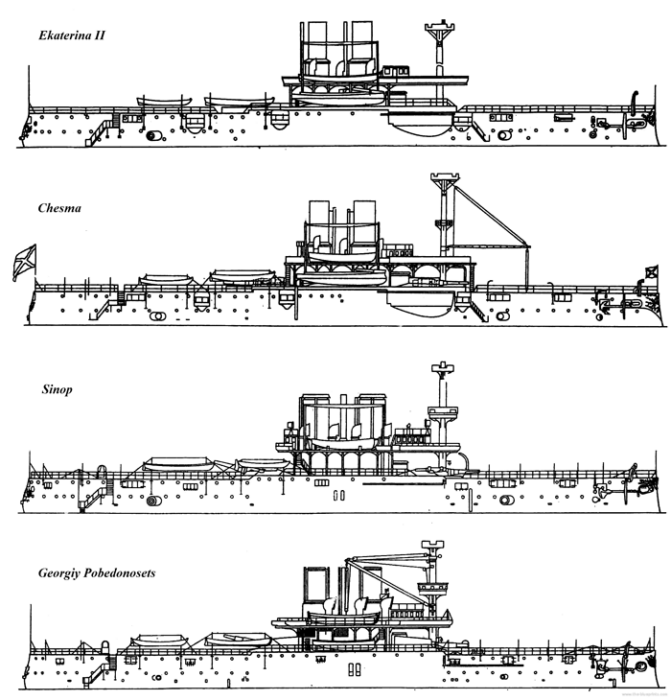
⚙ Ekaterina II specifications |
|
| Displacement | 11,050–11,396 long tons (11,227–11,579 t) |
| Dimensions | 339 ft 3 in x 68 ft 11 in x 27.92–28.83 ft (103.40 x 21 x 8.51–8.79 m) |
| Propulsion | 2 shafts compound/VTE, 14-16 cylindrical boilers: 9,000 ihp (6,711 kW) |
| Speed | 15–16.5 knots (27.8–30.6 km/h; 17.3–19.0 mph) |
| Range | 2,800 nmi (5,200 km; 3,200 mi) at 10 knots (19 km/h; 12 mph) |
| Armament | 3×2 305 mm, 7× 152 mm, 8× 47 mm 5-barrel Hotchkiss, 4× 37 mm 5-barrel Hotchkiss, 7× 360 mm TTs |
| Protection | Belt 203–406 mm, citadel 300 mm, Decks 51–64 mm, Gun shields 51–76 mm |
| Crew | 633–642 |
Career of
 Ekaterina II
Ekaterina II
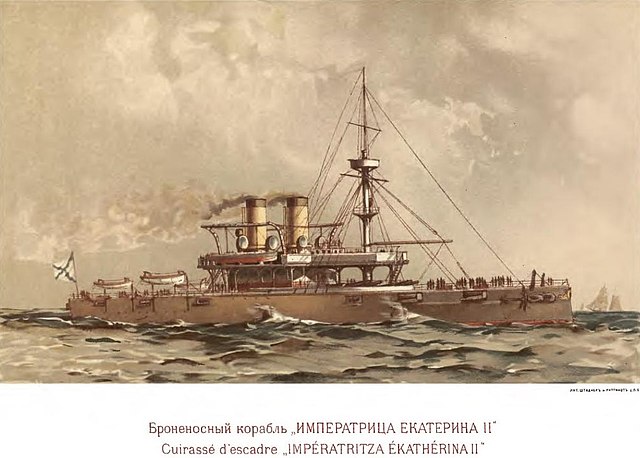
Ekaterina II was named after the Empress Catherine II of Russia. She was the only one of her class to be built at Nikolayev Admiralty Dockyard, Black sea. She was laid down on 26 June 1883, she was launched on 20 May 1886 and completed in 1889. First trials started a year prior, in 1888 and she was transferred to Sevastopol to be fitted ou, then accepted in the Black Sea Fleet. In 1897, the Naval General Staff wanted to have her equipped with new 12-inch 40-calibre guns and replace her compound armour on the redoubt with Krupp armor, but the Tsar’s entourage estimated it was too expensive. Only the machinery was upgraded between the mid-1898 and 1902. She received eighteen Belleville water-tube boilers whereas her engines were converted to triple expansion, so on trials she reached 9,978 ihp (7,441 kW) at 15 knots (28 km/h; 17 mph), on 8 November 1902.
Her crew was acquired to the revolutionary movement when Potemkin mutinied in June 1905. Her officers devised a plan to have the crew staying on deck or on shore leave as they disabled the powerplant. In order to prevent her from joining Potemkin, and left the ship, turning her over to the Sevastopol port authorities. She was never crewed again and stricken on 14 August 1907. Re-designated as “Stricken Vessel Nr. 3” on 22 April 1912 she was sunk as torpedo target. Her remnants were salvaged and scrapped in 1914.
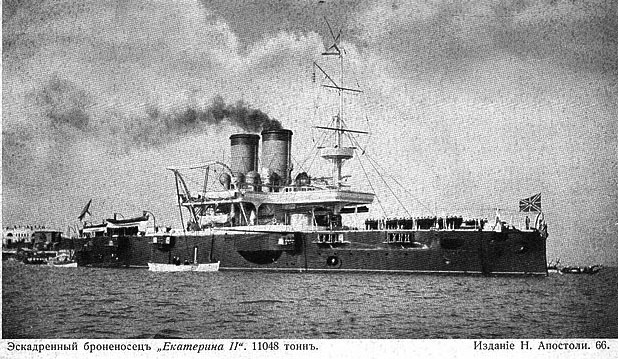
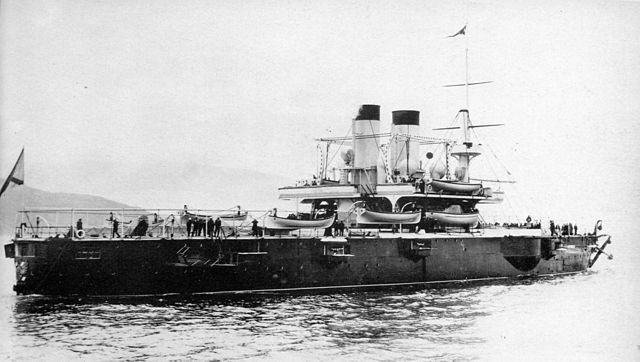
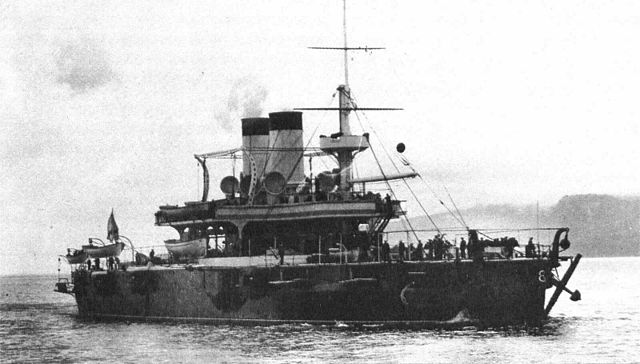
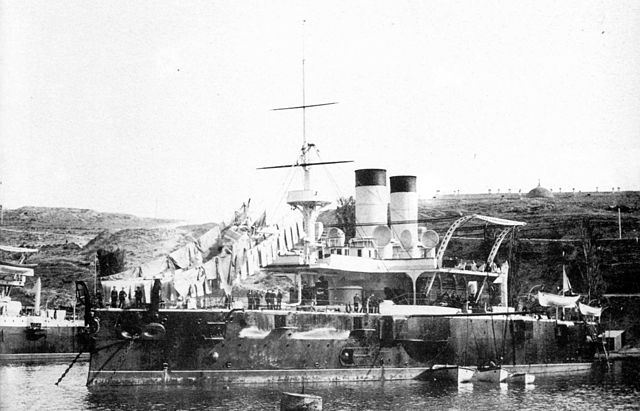
 Chesma
Chesma
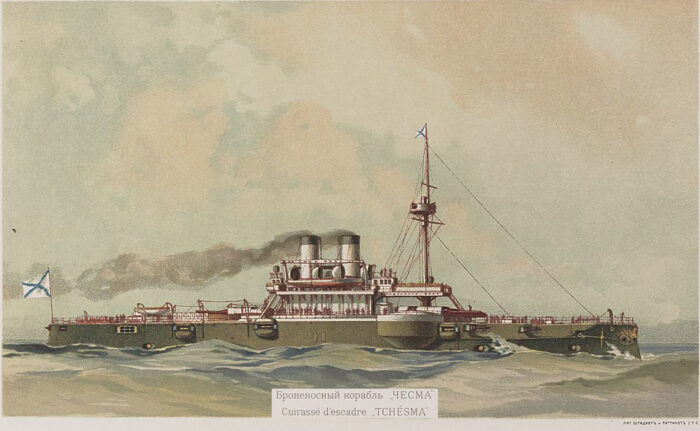
Chesma was named after the Russian Battle of Chesma in 1770. She was built ay the Russian Steam Navigation Company (RoPIT), Sevastopol, for the black sea fleet. She was laid down in late June 1883 and launched on 18 May 1886, then completed on 29 May 1889. Her crew was considered unreliable so during the mutiny her officers avoided problems by have her remaining and not taking part in the participate in the pursuit. Later she departed to escort Potemkin now interned at Constanta, Romania, and short of coal, by Sinop, back to Sevastopol. At her return, while Potemkine became Pantelimon and received a new crew, Chesma was turned over to the Sevastopol port authorities just like Ekaterina II, stricken on 14 August 1907. Her name was given to a new pre-dreadnought battleship. She was to be fully dismantled when the Naval Ministry decided to have full-scale armor trials. As “Stricken Vessel Nr. 4” on 22 April 1912 she ended as a gunnery target. Later she was used as a torpedo target for destroyers of the Black Sea Fleet. After torpedo hit she sank to the bottom of Tendra Bay. Sh was later raised and scrapped during the mid-1920s.
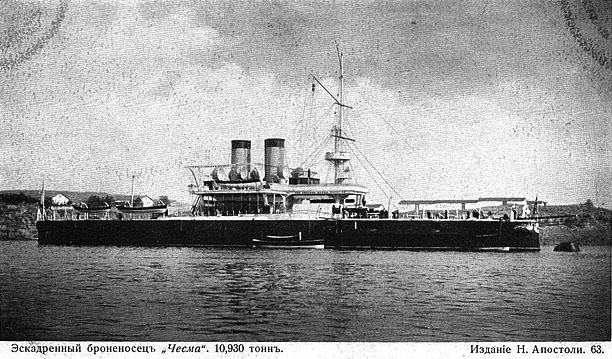
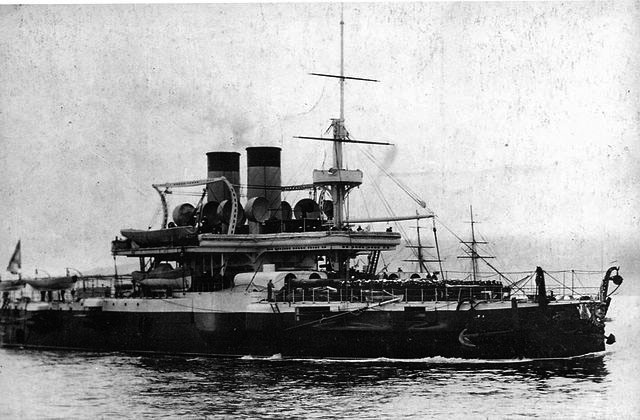
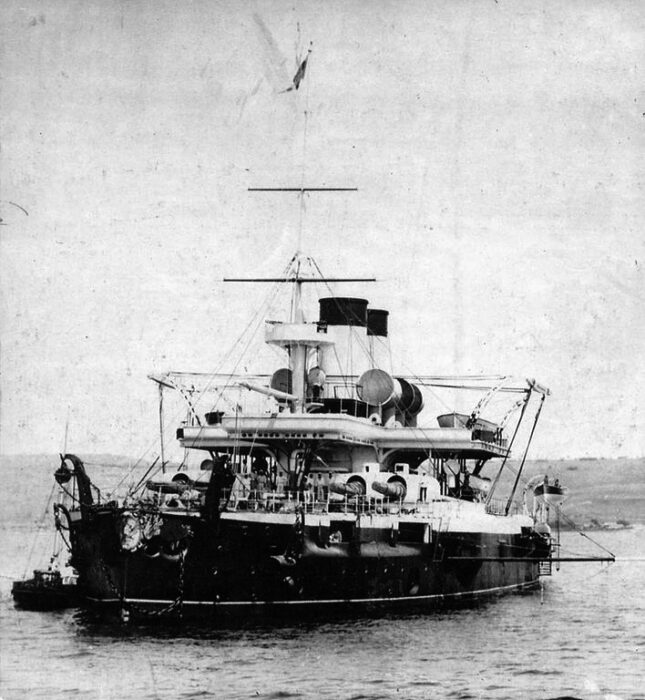
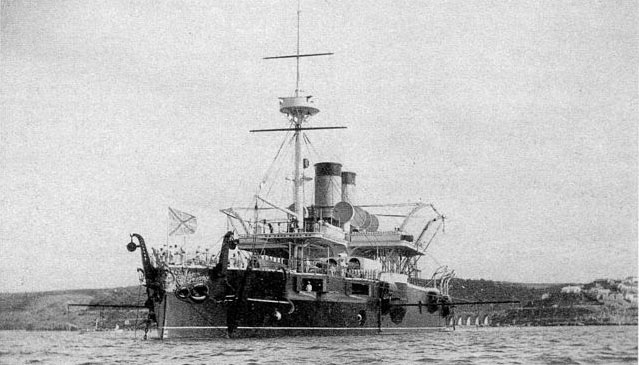
 Sinop
Sinop
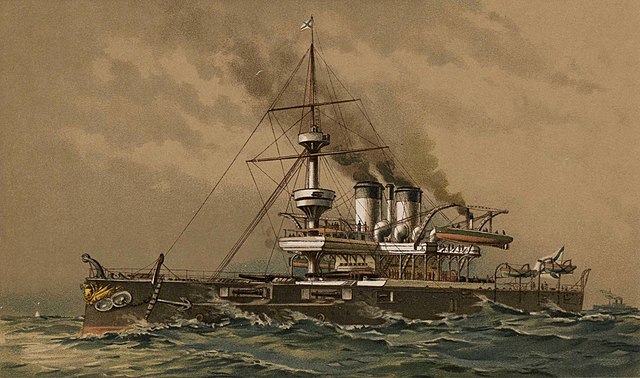
Sinop was named after the Russian victory of 1853. Laid down at the same yard as Chesma, Sevastopol RoPIT by late June 1883. She was launched on 1 June 1887 and completed in 1889. She was supposed to be the third and last of her class. She had successful trials and had a more reliable crew than her sister, so she was one of the ships launched in the pursuit of the Potemkin. The latter found asylum in Romania and the ship was turned over to the Russian squadron in Constanta. Short of coal, she was towed back to Sevastopol by Sinope. No records from 1906 onwards, to 1910. Afterwards in 1910, Sinope was was converted to a gunnery training ship. In 1912 she became a guardship at Sevastopol. Her 12-inch guns were removed and fin use on land fortification whereas she gain insteadfour single 8-inch (203 mm) guns in turrets. She thus served as such in 1914-15 but was refitted in 1916. She had torpedo bulges installed to just “eat mines” without danger, for a proposed operation in the heavily mined Bosphorus. Her postwar story is compicated. She was first captured by the Germans before the end of the war. Given her state, they had no plans for her. Then after the German capitulation, the British took over the port and all its ships. Knowing the Bolsheviks were close, they decided to scuttle her engines. This was a comprehensive destruction, so she would have needed long repairs. She was captured in that state by the Reds, and later the Whites recaptured her, all 1919. In 1921 she fell to the Bolsheviks agains. The latter had no plans for what was considered a relic with as much value as her scrap metal’s weight. She was thus completely dismantled and recycled by the Soviets from 1922.
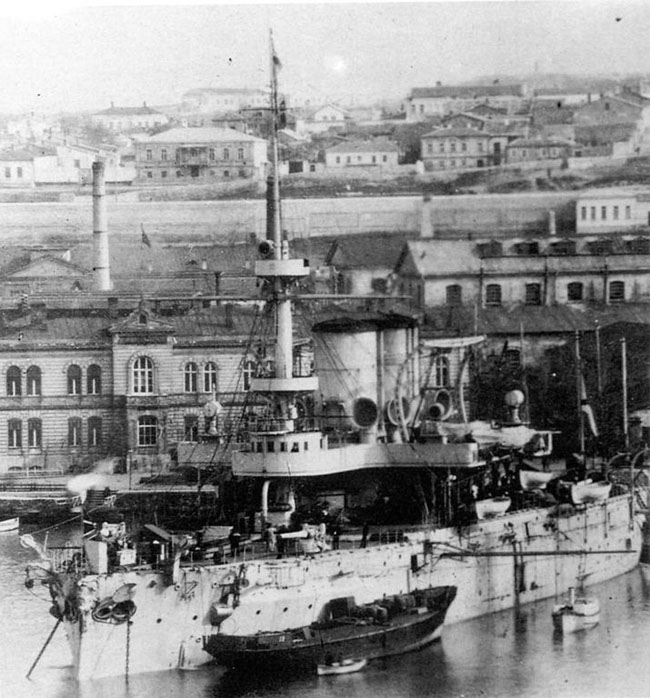
 Georgiy Pobedonosets
Georgiy Pobedonosets
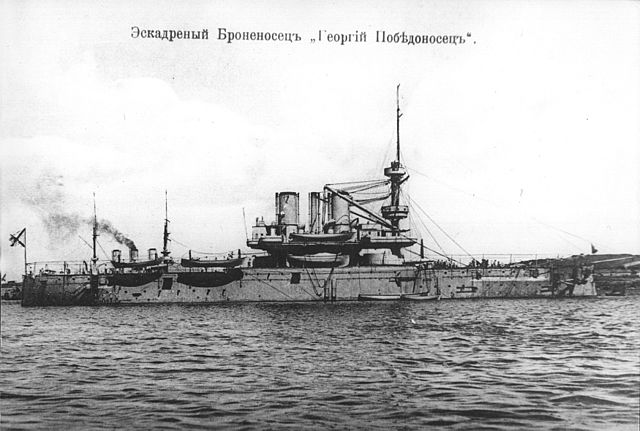
Georgii Pobedonosets, named after Saint George the Victorious, was the third laid down by RoPIT, Sevastopol, on 5 May 1891. She was launched on 9 March 1892 and completed in 1893, much faster than the six years of her sisters as her design was already complete. But she received scores of modifications. Authors are divided on having her classed as a Ekaterina II class of her own.
Trials lasted until mid-1895 and as a half-sister she had a modernized armor scheme, yet was overweight like the others. She took part in the pursuit of the Potemkin, until her own crew mutinied, took control of the ship and had the project to conduct her to Constanta in Romanian as well. In between loyal crew members led by officers regained control after just a day. They managed to have her running ground to prevent mutineers to take her back. It happened when Potemkin threatened to fire on her if she left Odessa.
In 1908 like her sisters she was considered obsolete, and her main guns were removed. She still have these when present as the Yavuz (ex Battlecruiser Goeben) started to bombar Sevastopol. She only managed to fire three rounds in 1914, only shots the entire class ever fired in anger. The rest of time she was used as floating headquarters ship, still in Sevastopol. She was eventually, like Sinope, captured by the Germans in 1918. As the latter surrendered, she was turned over by them to the British which, like Sinope, sabotaged her engines as they, in turn, abandonede Crimea in 1919 with Reds advaninc on the city. She was captured by both sides in fact in the Russian Civil War. She fell under White Russian control under Admiral Wrangel. Her decided to have the whole Black sea fleet confiscated from the Bolsheviks and sent to the nearest neutral port, hoping for their return after the re-estabishment of a new government. A events were pressing she was towed to Bizerte. She was interned there as events unfolded. The war was won by the Bolsheviks in 1923 and the new government had no plans for this elderly fleet in exile. Eventually an agreement was found between the French 3rd Republic and the Soviets, they were ceded to the French, and scrapped in Bizerte.

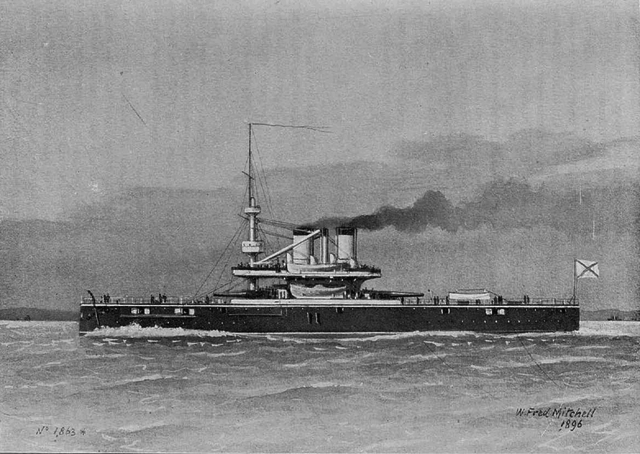
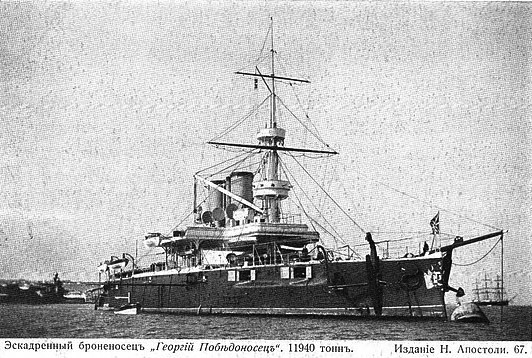
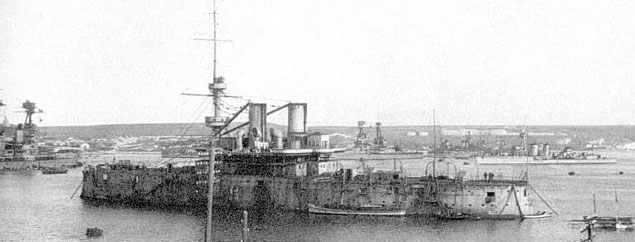
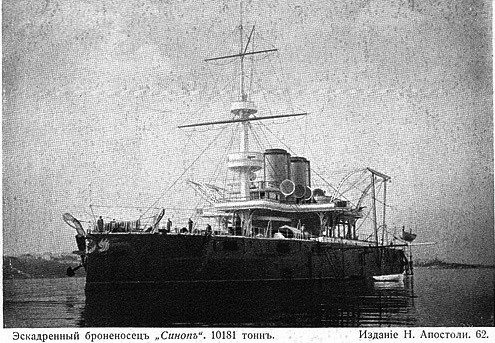
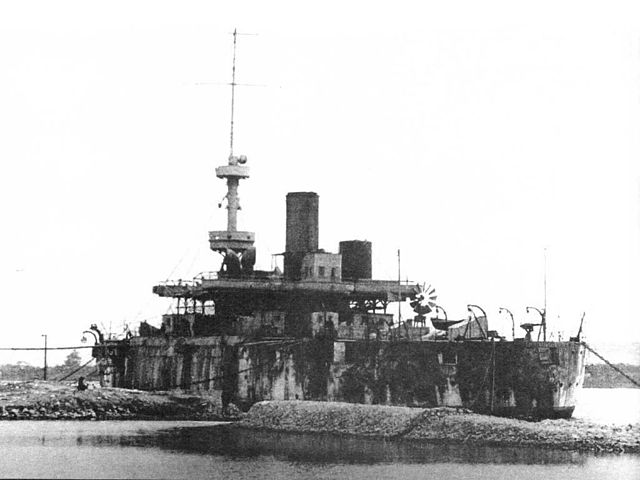
Read More/Src
Books
Conway’s all the world’s fighting ships 1860-1905
McLaughlin, Stephen (2003). Russian & Soviet Battleships. Annapolis, Naval Institute Press.
Jane, F.T., ed. (1904). Jane’s Fighting Ships. Sampson, Low, Marston, London.
Links
https://en.wikipedia.org/wiki/Ekaterina_II-class_battleship
Videos
None
Model Kits
1/700 Combrig Georgy Pobedonosets Battleship 1893
3D
None

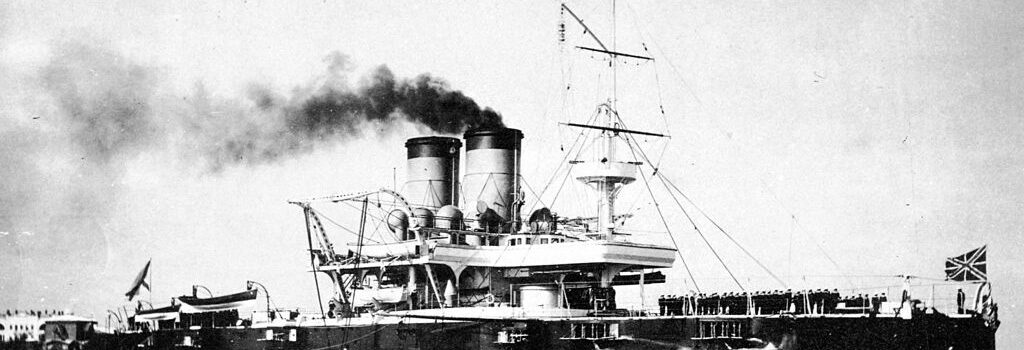

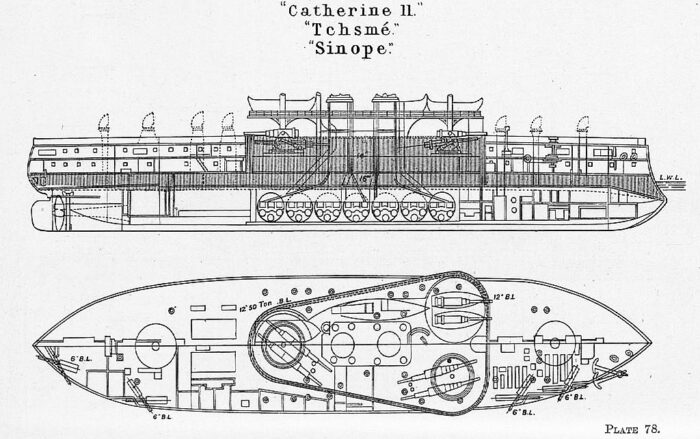

 Latest Facebook Entry -
Latest Facebook Entry -  X(Tweeter) Naval Encyclopedia's deck archive
X(Tweeter) Naval Encyclopedia's deck archive Instagram (@navalencyc)
Instagram (@navalencyc)





 French Navy
French Navy Royal Navy
Royal Navy Russian Navy
Russian Navy Armada Espanola
Armada Espanola Austrian Navy
Austrian Navy K.u.K. Kriegsmarine
K.u.K. Kriegsmarine Dansk Marine
Dansk Marine Nautiko Hellenon
Nautiko Hellenon Koninklije Marine 1870
Koninklije Marine 1870 Marinha do Brasil
Marinha do Brasil Osmanlı Donanması
Osmanlı Donanması Marina Do Peru
Marina Do Peru Marinha do Portugal
Marinha do Portugal Regia Marina 1870
Regia Marina 1870 Nihhon Kaigun 1870
Nihhon Kaigun 1870 Preußische Marine 1870
Preußische Marine 1870 Russkiy Flot 1870
Russkiy Flot 1870 Svenska marinen
Svenska marinen Søværnet
Søværnet Union Navy
Union Navy Confederate Navy
Confederate Navy Armada de Argentina
Armada de Argentina Imperial Chinese Navy
Imperial Chinese Navy Marinha do Portugal
Marinha do Portugal Mexico
Mexico Kaiserliche Marine
Kaiserliche Marine 1898 US Navy
1898 US Navy Sovietskiy Flot
Sovietskiy Flot Royal Canadian Navy
Royal Canadian Navy Royal Australian Navy
Royal Australian Navy RNZN Fleet
RNZN Fleet Chinese Navy 1937
Chinese Navy 1937 Kriegsmarine
Kriegsmarine Chilean Navy
Chilean Navy Danish Navy
Danish Navy Finnish Navy
Finnish Navy Hellenic Navy
Hellenic Navy Polish Navy
Polish Navy Romanian Navy
Romanian Navy Turkish Navy
Turkish Navy Royal Yugoslav Navy
Royal Yugoslav Navy Royal Thai Navy
Royal Thai Navy Minor Navies
Minor Navies Albania
Albania Austria
Austria Belgium
Belgium Columbia
Columbia Costa Rica
Costa Rica Cuba
Cuba Czechoslovakia
Czechoslovakia Dominican Republic
Dominican Republic Haiti
Haiti Hungary
Hungary Honduras
Honduras Estonia
Estonia Iceland
Iceland Eire
Eire Equador
Equador Iran
Iran Iraq
Iraq Latvia
Latvia Liberia
Liberia Lithuania
Lithuania Mandchukuo
Mandchukuo Morocco
Morocco Nicaragua
Nicaragua Persia
Persia San Salvador
San Salvador Sarawak
Sarawak Uruguay
Uruguay Venezuela
Venezuela Zanzibar
Zanzibar Warsaw Pact Navies
Warsaw Pact Navies Bulgaria
Bulgaria Hungary
Hungary

 Bundesmarine
Bundesmarine Dutch Navy
Dutch Navy Hellenic Navy
Hellenic Navy Marina Militare
Marina Militare Yugoslav Navy
Yugoslav Navy Chinese Navy
Chinese Navy Indian Navy
Indian Navy Indonesian Navy
Indonesian Navy JMSDF
JMSDF North Korean Navy
North Korean Navy Pakistani Navy
Pakistani Navy Philippines Navy
Philippines Navy ROKN
ROKN Rep. of Singapore Navy
Rep. of Singapore Navy Taiwanese Navy
Taiwanese Navy IDF Navy
IDF Navy Saudi Navy
Saudi Navy Royal New Zealand Navy
Royal New Zealand Navy Egyptian Navy
Egyptian Navy South African Navy
South African Navy






























 Ukrainian Navy
Ukrainian Navy dbodesign
dbodesign